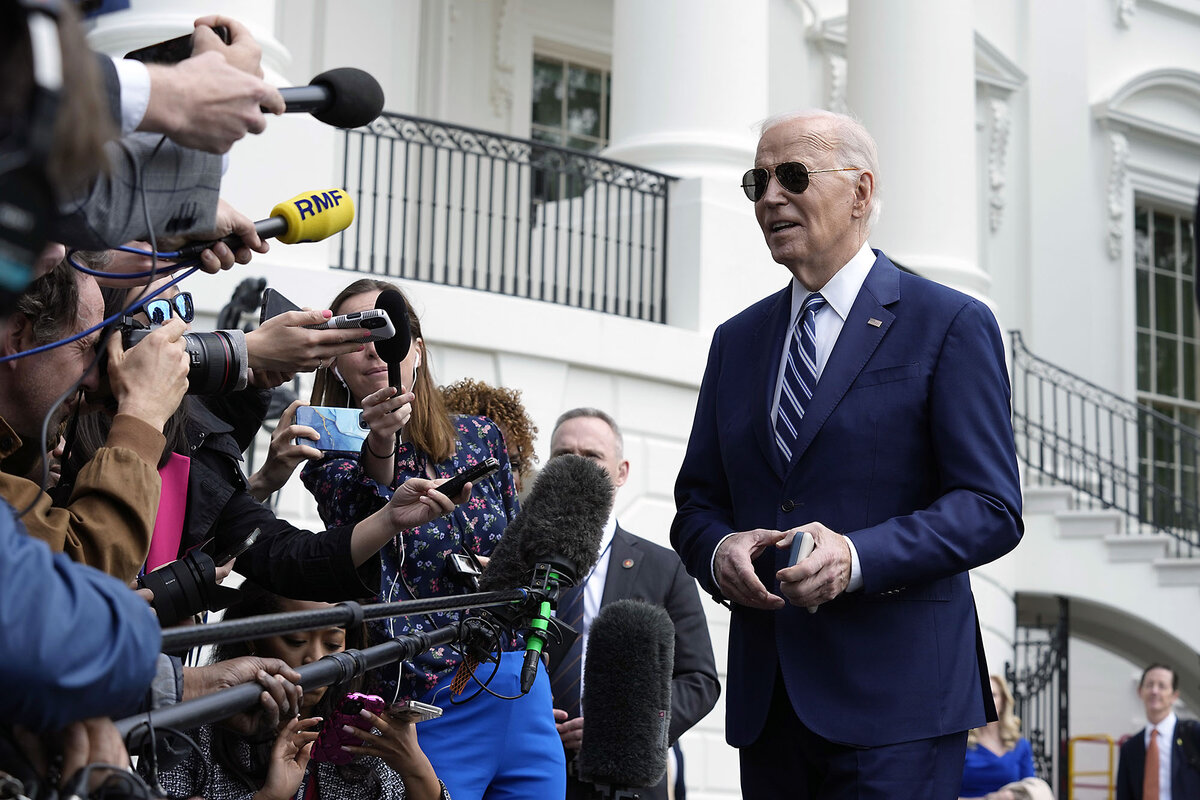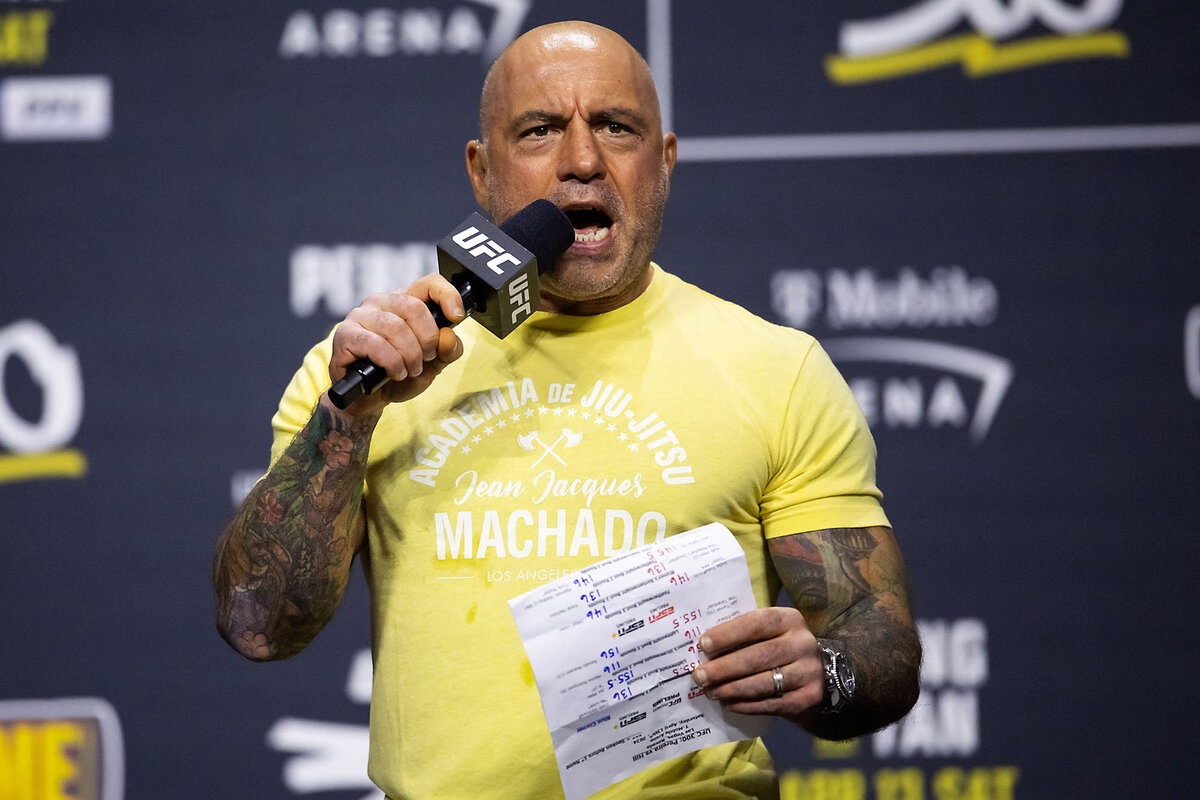Trust in the media has tanked. Are we entering a ‘post-news’ era?
Loading...
Growing up in the pre-internet era, Mosheh Oinounou got his news the old-fashioned way.
“We’d wait in the morning for the [Chicago] Tribune to land on the driveway and see what happened in the world,” he says. There was also news on the radio and TV, where Mr. Oinounou built his career as a producer for CBS, Fox, and Bloomberg.
Today, that world of stable news diets – with its finite set of media sources that reached many U.S. households one way or another – has been swept away by an online tsunami of information. Half of U.S. adults now get their news, at least in part, from social media. That has sharply cut into revenues for newspapers and other publishers of news content, as digital platforms like Facebook, Instagram, and Google have sucked up most of the advertising dollars that for decades had underwritten most journalism. In 2006, U.S. newspapers took in $49 billion in advertising revenues. By 2022, that amount had fallen to less than $10 billion.
Why We Wrote This
A story focused onDeclining trust in the news media isn’t just about how polarization affects journalists and the public. It’s also about navigating a tsunami of digital content. Do people have room for news in their lives? How do they judge quality?
These digital platforms are not only shaping how and when Americans get their news – they’re increasingly steering them away from it altogether, by deprioritizing news in their algorithmic feeds. Ironically, while today’s news consumers have greater access than ever before to a broad spectrum of information and viewpoints, much of it for free, many citizens are choosing a daily diet of podcasts, videos, and other digital content that circumvents more serious “hard news” altogether.
Some of today’s news-avoiders say it’s the media’s own fault. Many people no longer trust journalists to report the news accurately and fairly, says Benjamin Toff, an assistant professor of journalism at the University of Minnesota and co-author of “Avoiding the News: Reluctant Audiences for Journalism.”
This distrust is shared even by some of those who still consume news regularly. In the United States, conservatives have long objected to what they say is a liberal bias in mainstream news organizations, a sentiment that has helped fuel the growth of a right-wing media ecosystem. Over the past decade, former President Donald Trump greatly accelerated this distrust by railing on the “fake news” media, often in an attempt to discredit critical headlines about him.
Still, arguments over media bias may miss the larger point – that a growing number of people simply are tuning out news entirely.
“There’s a larger segment of the public [that is] mostly just indifferent towards news,” says Professor Toff. “They will say in a survey that they are distrusting, but it’s not a deep-seated distrust. It’s actually more of a skepticism about the value and relevance of news to their lives.”
To be sure, many have long disparaged the news as depressing, boring, or irrelevant. Nevertheless, for much of the previous century, it worked its way into most Americans’ daily lives either via a newspaper that was primarily purchased for sports and weather or on a TV newscast that was left on between shows. Today, the internet and the rise of streaming make that kind of casual consumption –the news as ambient noise – far less likely.
“We used to rely on the newspaper industry introducing new facts into our media ecosystem. And it’s precisely that part of the infrastructure that’s disappearing,” says Victor Pickard, a professor of media policy at the University of Pennsylvania.
No longer a common set of facts
Overall trust in the news media has been falling for decades, along with a broader loss of trust in other public institutions. Four in 10 Americans today say they have “no confidence” in the media’s news reporting, while only 32% have a “great deal” or “fair amount” of confidence. Back in 2003, when Gallup asked the same question, only 1 in 10 expressed “no confidence” while more than half expressed confidence.
This decline in trust in a free press and the demise of traditional news habits are likely to have major consequences. For the journalism industry, it’s created a kind of death spiral. Around 3,000 newspapers have closed since 2005; more than 200 counties across America now have no local news providers. As news outlets shutter or lay off reporters and editors in an effort to cut costs, it becomes even harder to win back the trust of their audiences.
But more broadly, the lack of shared news can lead to a citizenry no longer able to engage with one another based on a common set of facts and ideas. Democracies rely on informed voters with some sort of baseline knowledge on which to base their choices. Disengagement with news typically goes hand in hand with disengagement with politics, voting, and civic life.
News media travails: disruption, divides, and disinformation
Of course, the digital disruption of journalism doesn’t mean that all news reporting is about to vanish. A handful of large media organizations with relatively affluent subscribers may continue to survive, along with public broadcasters and national news networks tethered to (and subsidized by) entertainment divisions.
But their relative success may only deepen the divide between the small subset of voters who are well informed about public affairs and those on the outside looking in – or looking away.
“Not only is [fact-based news] becoming more scarce, as in there are fewer journalists, fewer news organizations out there, but also the reliable, high-quality news media is going behind paywalls,” says Professor Pickard, author of “Democracy Without Journalism? Confronting the Misinformation Society.”
Cable news, the original disruptor for TV network news in its day, now serves a largely baby boomer audience: The median ages of viewers of Fox, CNN, and MSNBC are between 67 and 71.
In the fragmented digital realm, where opinion and amateur video often muscle out evidence-based journalism, expertise no longer holds weight, says Jeffrey Dvorkin, a former ombudsperson at NPR and author of “Trusting the News in a Digital Era.” Conspiracy theories thrive in such spaces, as does disinformation by Russia and other foreign powers.
This fragmentation has undercut the authority of traditional news sources. It “becomes a kind of rallying point for people to say, ‘Well, I don’t trust anybody. I don’t trust governments; I don’t trust the media; I don’t trust churches; I don’t trust universities. I trust what I feel is important to me,’” says Mr. Dvorkin. “They look for ideas and expressions that confirm their own feelings rather than inform them.”
Content providers know that shock and sensation drive engagement, which social media algorithms often reinforce. For example, video recommendations on TikTok have tended to showcase images from the war in Gaza that skew heavily to pro-Palestinian perspectives. Most of these videos don’t come from news organizations, which vet images and provide context, but are posted by activists, provocateurs, and influencers. Some have later been found to be fraudulent or misleading.
In a 2023 Pew Research Center poll, 32% of respondents ages 18-29 said they regularly get their news on TikTok, which favors short-form, user-generated videos.
Professor Toff led a three-year global research project on trust in news at the Reuters Institute for the Study of Journalism at Oxford University. The researchers found that growing U.S. distrust in the news media was mirrored in other democracies, even as voters also worried about the veracity of social media content.
“A lot of people have internalized the notion that the smarter way to behave online is to be distrusting of everything you see because of just how varied the media environment is. And that, I think, can lead to the sort of generalized distrust that makes it harder to actually engage in the world,” says Professor Toff.
News organizations trying to attract younger audiences face a particularly difficult dilemma when it comes to social media. Allowing social media to disseminate their content means their stories are often presented alongside inflammatory and unreliable commentary, which can further degrade their brand. But irrelevance may be a worse outcome, particularly when more users are filtering out traditional news sources and are becoming impervious to the markers of reputable journalism.
The use of artificial intelligence to generate vast quantities of news content, as well as fake images and audio, adds to the challenge for independent, fact-based news outlets. Online audiences who already struggle with media literacy are likely to see an increase in AI-generated fake news, adding to general distrust towards all sources of news.
Startups that destress news
Lately, a crop of news influencers on platforms like Instagram and TikTok has been trying to reach younger audiences who are skeptical or indifferent toward traditional journalism. They aggregate and analyze news, downplay partisan spin, and use comments to respond to readers and to decide what topics to cover next.
One of them is Mr. Oinounou, the former TV producer. He began sharing news on Instagram during the first wave of COVID-19 in 2020. What started as a service for family and friends has become a fast-growing news operation, called Mo News, with premium subscriptions and newsletters. His Instagram account, which aggregates news from mainstream outlets under plain, descriptive headlines, has more than 400,000 followers. Most, he says, are women in their mid-30s.
“I think there’s an audience out there that continues to remain hungry for news. They’re just finding it in different ways,” he says. This audience “is coming to social media for their home advice, for their parenting advice – and for information and news related to a whole variety of subjects, and that includes political news.”
RocaNews, another startup that has around 1.5 million consumers of its bite-size news products, including a popular news-quiz app, also launched in 2020. Max Frost, a co-founder and president, says his Generation Z audience is looking for facts and context without political spin or sensationalism. “One of our missions is to destress the news. It raises the blood pressure to read the news, and it shouldn’t be that way,” he says.
Mr. Frost says many young social media users don’t see themselves reflected in stories from major news outlets, such as when they read upbeat coverage of an economy that feels stacked against them. “They don’t have money in the stock market. They don’t own property,” he says.
These blind spots cut across generations, says Tanzina Vega, the former host of “The Takeaway,” a national news show produced by WNYC. “There’s a huge class gap,” she says. “I don’t see a lot of media that’s for the working class.” With the journalism industry in such financial turmoil, more publishers are focused on wooing premium subscribers, who tend to be more affluent and politically engaged, which then shapes editorial priorities.
Younger radio audiences are gravitating to podcasters like Joe Rogan and Charlamagne tha God, who mix selectively sourced conversations about news with entertainment and eschew the conventions of journalism, says Ms. Vega, a former CNN reporter. “There’s a [quality] of relatability that people like Joe Rogan have, for better or worse. They’ve found an opening. People say, ‘This guy is one of us,’” she says.
Mr. Oinounou says he builds trust with his Mo News followers by showing his work – stories are credited to original sources – and by admitting the limits of his knowledge, not hyping his hot takes. He tells readers, “I don’t know what’s going to happen here, but here are a few ways to think about it.”
He also encourages his readers to go to well-sourced reporting by outlets like The New York Times so they can better understand the complex stories he summarizes. Some tell him that there’s no need, since he’s already “vetted” the story; the trust runs to him and through him, but no further.
“It’s very interesting to hear the lack of trust in official sources,’’ he says. “It’s almost as if [when] you take it through somebody, that somehow brings more trust.”









